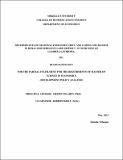| dc.description.abstract | The main objective of the study was to investigate the determinants of seasonal food insecurity status of farming rural households, to identify factors influencing rural households‟ food insecurity status and to find out the coping mechanism. In light of this, examinations of the demographic and socio economic characteristics of sampled households were undertaken. The necessary data were extracted from primary data of sampled rural households. In this study, two stage probability proportional to size sampling procedure was employed to select 6 kebeles and 120 sample households out of 28 kebeles of the study areas. For the purpose, survey questionnaire was prepared to collect the primary data from sampled rural households. The data was analyzed by SPSS statistics version 19, econometrics model and descriptive statistics. The specific statistic used includes, mean, standard deviation, percentage, tables, figures and frequency distribution. In addition, t and chi-square tests were used to compare food secure and insecure sample groups with respect to explanatory variables A binary logistic model was used to identify the determinants of seasonal food insecurity. A total of sixteen explanatory variables, 9 continuous and 7 discrete, were included in the empirical model. Out of these, nine were found to be statistically significant. These variables include household size (HHSZE), marital status of household head(MRSTHHH), dependent ratio(DEPRATIO), owned milking cow (NUMMKCOW), livestock holding (TLU), on farm income(ONFMIN), farm land size (FLSZ), cultivated own land (CULTOWNLAND) and number of household members actively participant in activities (NUMHHMPACTS). The result of the study revealed that 80.8% of sampled rural households in study area were food insecure and it was check by using recommended minimum calorie requirement (i.e., 2200kcal) whereas 19.2% of sampled rural household was food secure. On other hand, sale of livestock, sale milk and milky product, fishing, selling of fire wood, borrow grain/cash and gathering wild fruit, were found to be more frequently practiced as mean of coping mechanism used by people in study area. The finding suggest the following set of policy recommendation, limiting population size, and improve the production and productivity of the agriculture sector in longer term, educate people to catch up with model technology like improved seed, utility of farm size, introducing the use of fertilizer, modeling livestock rearing, creating enable economic and saving institutional environment were recommended. | en_GB |


